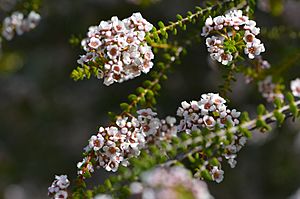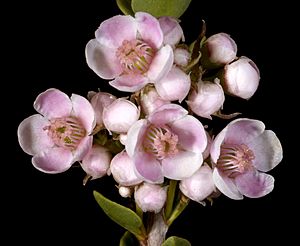Spiked scholtzia facts for kids
Quick facts for kids Spiked scholtzia |
|
|---|---|
 |
|
 |
|
| Scientific classification | |
| Genus: |
Scholtzia
|
| Species: |
involucrata
|
The Scholtzia involucrata, also known as the spiked scholtzia, is a type of shrub. It belongs to the Myrtaceae family, which includes plants like eucalyptus. This plant is special because it is endemic to Western Australia. This means it naturally grows only in Western Australia and nowhere else in the world!
About the Spiked Scholtzia
The spiked scholtzia is a shrub, which is a woody plant smaller than a tree. It can grow upright or spread out low to the ground.
What Does It Look Like?
This shrub usually grows to be about 0.2 to 1.5 meters (0.7 to 4.9 feet) tall. Its leaves are always green, so it's called an evergreen plant. Each leaf is quite small, about 4 to 9 millimeters (0.16 to 0.35 inches) long.
The spiked scholtzia has pretty pink-white flowers. These flowers bloom for several months, from November all the way through May. Each flower is tiny, only about 8 millimeters (0.31 inches) wide.
Where Does It Grow?
You can find the spiked scholtzia in sandy areas along the west coast of Western Australia. It grows in places like sand plains and on ridges. These areas are part of the Wheatbelt and Peel regions.
This plant is often found growing in sandy soils. It is part of the "understorey" in certain plant communities. The understorey is the layer of plants that grows beneath the main canopy of trees. It lives in areas called kwongan or Banksia woodlands. Kwongan is a type of shrubland unique to Western Australia.
How Was It Named?
The spiked scholtzia was first officially described in 1917. A botanist named George Claridge Druce gave it its formal scientific name. He wrote about it in a report for a botanical club.
Sometimes, plants can have different names over time. For the spiked scholtzia, there are three other names it was once known by. These older names are Baeckea obovata, Scholtzia obovata, and Baeckea involucrata. These are called "synonyms," which means they are different scientific names for the same plant.

